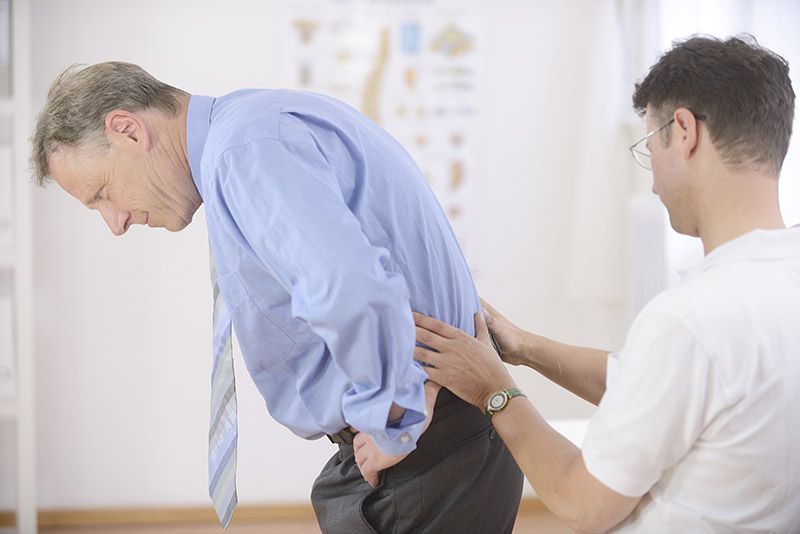
Disc bulges slipped disc and sciatica
For a Physiotherapist, Osteopath and General Practitioners disc bulges, slipped disc and sciatica are commonly presenting conditions. There is often a lot of confusion around Disc bulges, slipped disc and sciatica. Symptoms can vary significantly between people
What is a disc?
A disc is a spongy shock absorbing tissue in your spine located between each of the vertebra from your neck to your tail bone. The role of the disc is to absorb shock and forces coming through the spine in order to protect the vertebra and surrounding structures.
What are Disc Bulges?
When one or more of these discs start to degenerate or breakdown allowing the soft central part of the disc to bulge and distort in shape, protrude or even in severe cases herniate.
When the disc does this, the space it bulges or protrudes into contains important nerves that are coming out from or into your spinal cord.
The symptoms will vary depending on the level in the spine and exactly what structures and nerves are being irritated or compressed by the disc bulge. Disc bulges happen most commonly in the lower back and less commonly in the neck.
All disc bulges require expert investigation by a health professional and imaging of the spine and discs in order to accurately diagnose this condition.
What are the signs and symptoms?
- Usually a fit young adult (20-45yrs)
- Onset may be nothing or a minor strain such as bending, twisting or lifting, pain onset may be days later.
- Pain can be dull, aching or knife like, felt centrally or on one side usually in the lower back or down the leg
- Initially pain may be intermittent and relieved by change in positionPain is often aggravated by sitting, straining, coughing as well as sneezing
- Pain usually becomes severe and as a result may disturb sleep
- Patient may have had previous ‘episodes’
- Leg pain may follow back pain usually just on one side
- associated neurological (nerve) symptoms may also include parathesia, numbness, leg cramps or weakness
What is the treatment?
- You should consult your Osteopath so that they can assess your signs and symptoms and examine you in order to diagnose your pain correctly.
- You will probably need to be referred for imaging (if you have not been already) in order to confirm the diagnosis
- Stretches, general exercise, ergonomic modification and rehabilitation exercises have also been shown to be effective. Your Osteopath or Physio can advise you on exactly what exercises and also how to do them
- Your Osteopath or Physio may be able to help relieve some of the associated muscle pain and pressure with treatment and as a result this may assist your ‘episode’ to settle
- Medications such as anti-inflammatories and analgesics can be helpful but should only be taken under the direction of a health care professional. Long term use of medications can have serious side effects
- In severe cases when the ‘episode’ of pain does not settle you may need to be referred to a specialist. A specialist may be able to help reduce inflammation by also referring for corticosteroid and other injections intended to reduce or control inflammation and pain.
- Finally in severe cases a surgical opinion may be required.
What is the prognosis?
- Symptoms associate with disc bulges can resolve with conservative treatment. They can not however be pushed, massaged or manipulated back into place.
- Episodes of pain caused by the disc bulge may settle but the bulge is often still present and care must be taken not to re-irritate the disc bulge.
- Specific exercises, stretches and lifestyle modifications will help to avoid re-occurrence and stop further degeneration.
- Disc bulges can often become long term problems with ‘episodes’ of reoccurrence over many years, however if you are overweight, reducing down to a healthy weight will help to improve the condition
What not to do
- Lifting, bending and also twisting movements
- Coughing, straining and also jarring movements.
- Start your own stretches or exercises without expert advice because some stretches and exercises will cause more damage and pain
- Self diagnose or self prescribe medications
Further reading
If you are interested in finding out what the scientific literature says about manual therapy in the presence of disc bulge here are some articles that are free to read
- Boyles R, Toy P, Mellon J Jr, Hayes M, Hammer B. Effectiveness of manual physical therapy in the treatment of cervical radiculopathy: a systematic review. J Man Manip Ther. 2011;19(3):135–142. read here.
- VanGelder LH, Hoogenboom BJ, Vaughn DW. A phased rehabilitation protocol for athletes with lumbar intervertebral disc herniation. Int J Sports Phys Ther. 2013;8(4):482–516. Read here.
- Albert HB, Hauge E, Manniche C. Centralization in patients with sciatica: are pain responses to repeated movement and positioning associated with outcome or types of disc lesions? Eur Spine J. 2012;21(4):630–636. Read here.
- Keramat KU, Gaughran A. Safe physiotherapy interventions in large cervical disc herniations. BMJ Case Rep. 2012;2012:bcr2012006864. Read here.
- Langevin P, Desmeules F, Lamothe M, Robitaille S, Roy JS. Comparison of 2 manual therapy and exercise protocols for cervical radiculopathy: a randomized clinical trial evaluating short-term effects. J Orthop Sports Phys Ther. 2015;45(1):4-17. Read here.
